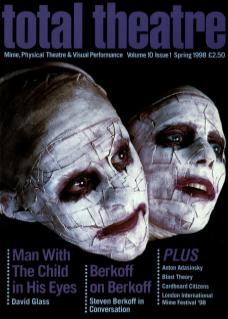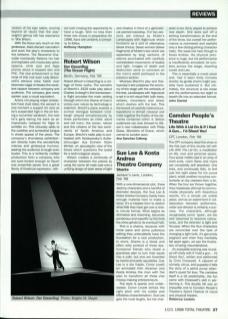Robert Wilson's Ozeanflug is a collage of three works. The scenario of Brecht's 1929 radio play about Charles Lindbergh's first transoceanic flight provides the main setting through which the theme of man's victory over nature by technology is explored. Brecht's piece evolves a surreal dialogue between Lindbergh (played simultaneously by three performers as child, adult and old man), the ocean, nature and the citizens of the two continents of North America and Europe. Brecht's radio play is contrasted with Dostoyevsky’s Aufzeichnungen Aus Einem Toten Winkel, an apocalyptic view of the future which questions the quest for a technological utopia.
Wilson creates a continuity of character between the pieces by using the same all-male cast and a unifying design of stark areas of light and shadow in front of a geometrical painted backdrop. The two sections are intercut by Muller's Landscapes with Argonauts which functions as a sort of alternative Greek chorus. Seven women deliver fragments of Muller's text which are separated by long sections of silence punctuated with carefully orchestrated movements of bodies and light. Images of death and destruction serve to comment on the men's world portrayed in the previous section.
Whereas Brecht's play and Dostoyevsky’s text juxtapose the economy of the stage with the verbosity of the text, Landscapes with Argonauts is set in a rich visual field (with trees, settees, mountains and skies) which clashes with the text. This framework of carefully balanced juxtapositions is almost classical and holds together the fluidity of the elements contained within it. British audiences can look forward to Wilson's new collaboration with Philip Glass, Monsters of Grace, which comes to London soon.

